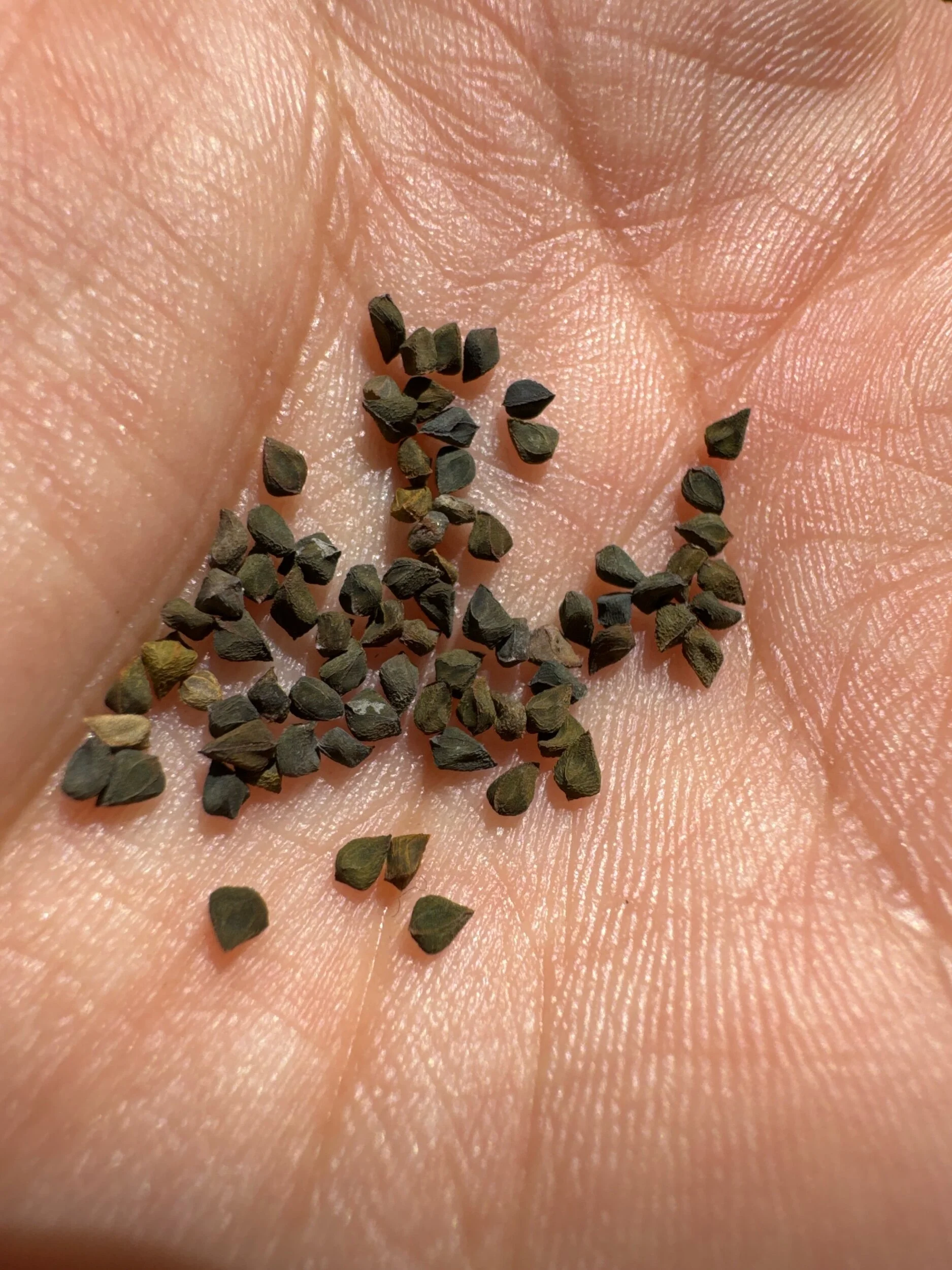Egyptian Spinach Seeds [Corchorus olitorius]
History and Cultural Uses:
Egyptian Spinach, also known as Molokhia or Jew's Mallow, has a rich history dating back to ancient Egypt. It was cultivated along the Nile River and prized for its culinary and medicinal properties. Egyptian Spinach is still a staple in Middle Eastern and North African cuisines, where it is used in soups, stews, and as a side dish. Its leaves are known for their mucilaginous texture, adding depth and flavor to various dishes.
Nutritional Benefits:
Vitamins: Rich in vitamins A, C, and K, Egyptian Spinach supports healthy vision, immune function, and blood clotting.
Minerals: High in minerals such as calcium, iron, and magnesium, Egyptian Spinach promotes bone health, oxygen transport, and muscle function.
Fiber: A good source of dietary fiber, Egyptian Spinach aids digestion and promotes satiety, helping to regulate blood sugar levels and prevent constipation.
Antioxidants: Contains antioxidants like beta-carotene and flavonoids, which help reduce inflammation, protect against oxidative stress, and lower the risk of chronic diseases.
Culinary Uses:
🍲Soups and Stews: Egyptian Spinach is commonly used to thicken and flavor soups and stews, adding a unique texture and taste to traditional dishes.
🥗Salads: Its tender leaves can be enjoyed raw in salads, providing a fresh and nutritious addition to any meal.
🌿Side Dishes: Sauteed or steamed, Egyptian Spinach makes a delicious and versatile side dish, complementing a wide range of flavors and cuisines.
Plant Care:
⏰: sow in late spring or early summer when the soil is warm.
🪱: Well – drained, organically enrich soil with a pH of 6.0 to 7.0.
🕳️: sow seeds, 1/4 to one half inch deep, 12 to 18 inches apart.
🌱: seeds germinate in 7 to 14 days; maintain consistent moisture.
💦: keep soil constantly moist, avoiding waterlogging.
☀️: plant in full sun; 6 to 8 hours of sunlight daily.
✂️: if necessary, thin seedlings at 3 to 4 inches height.
🌾: begin harvesting young leaves, when plant is 12 to 18 inches tall for continuous growth.
HAPPY GROWING!🌿☺️ (30+ seeds in each)
Whether you're exploring new culinary adventures, or simply looking to boost your overall wellness, Egyptian Spinach offers a flavorful and healthful addition to your diet and food forest!
History and Cultural Uses:
Egyptian Spinach, also known as Molokhia or Jew's Mallow, has a rich history dating back to ancient Egypt. It was cultivated along the Nile River and prized for its culinary and medicinal properties. Egyptian Spinach is still a staple in Middle Eastern and North African cuisines, where it is used in soups, stews, and as a side dish. Its leaves are known for their mucilaginous texture, adding depth and flavor to various dishes.
Nutritional Benefits:
Vitamins: Rich in vitamins A, C, and K, Egyptian Spinach supports healthy vision, immune function, and blood clotting.
Minerals: High in minerals such as calcium, iron, and magnesium, Egyptian Spinach promotes bone health, oxygen transport, and muscle function.
Fiber: A good source of dietary fiber, Egyptian Spinach aids digestion and promotes satiety, helping to regulate blood sugar levels and prevent constipation.
Antioxidants: Contains antioxidants like beta-carotene and flavonoids, which help reduce inflammation, protect against oxidative stress, and lower the risk of chronic diseases.
Culinary Uses:
🍲Soups and Stews: Egyptian Spinach is commonly used to thicken and flavor soups and stews, adding a unique texture and taste to traditional dishes.
🥗Salads: Its tender leaves can be enjoyed raw in salads, providing a fresh and nutritious addition to any meal.
🌿Side Dishes: Sauteed or steamed, Egyptian Spinach makes a delicious and versatile side dish, complementing a wide range of flavors and cuisines.
Plant Care:
⏰: sow in late spring or early summer when the soil is warm.
🪱: Well – drained, organically enrich soil with a pH of 6.0 to 7.0.
🕳️: sow seeds, 1/4 to one half inch deep, 12 to 18 inches apart.
🌱: seeds germinate in 7 to 14 days; maintain consistent moisture.
💦: keep soil constantly moist, avoiding waterlogging.
☀️: plant in full sun; 6 to 8 hours of sunlight daily.
✂️: if necessary, thin seedlings at 3 to 4 inches height.
🌾: begin harvesting young leaves, when plant is 12 to 18 inches tall for continuous growth.
HAPPY GROWING!🌿☺️ (30+ seeds in each)
Whether you're exploring new culinary adventures, or simply looking to boost your overall wellness, Egyptian Spinach offers a flavorful and healthful addition to your diet and food forest!
History and Cultural Uses:
Egyptian Spinach, also known as Molokhia or Jew's Mallow, has a rich history dating back to ancient Egypt. It was cultivated along the Nile River and prized for its culinary and medicinal properties. Egyptian Spinach is still a staple in Middle Eastern and North African cuisines, where it is used in soups, stews, and as a side dish. Its leaves are known for their mucilaginous texture, adding depth and flavor to various dishes.
Nutritional Benefits:
Vitamins: Rich in vitamins A, C, and K, Egyptian Spinach supports healthy vision, immune function, and blood clotting.
Minerals: High in minerals such as calcium, iron, and magnesium, Egyptian Spinach promotes bone health, oxygen transport, and muscle function.
Fiber: A good source of dietary fiber, Egyptian Spinach aids digestion and promotes satiety, helping to regulate blood sugar levels and prevent constipation.
Antioxidants: Contains antioxidants like beta-carotene and flavonoids, which help reduce inflammation, protect against oxidative stress, and lower the risk of chronic diseases.
Culinary Uses:
🍲Soups and Stews: Egyptian Spinach is commonly used to thicken and flavor soups and stews, adding a unique texture and taste to traditional dishes.
🥗Salads: Its tender leaves can be enjoyed raw in salads, providing a fresh and nutritious addition to any meal.
🌿Side Dishes: Sauteed or steamed, Egyptian Spinach makes a delicious and versatile side dish, complementing a wide range of flavors and cuisines.
Plant Care:
⏰: sow in late spring or early summer when the soil is warm.
🪱: Well – drained, organically enrich soil with a pH of 6.0 to 7.0.
🕳️: sow seeds, 1/4 to one half inch deep, 12 to 18 inches apart.
🌱: seeds germinate in 7 to 14 days; maintain consistent moisture.
💦: keep soil constantly moist, avoiding waterlogging.
☀️: plant in full sun; 6 to 8 hours of sunlight daily.
✂️: if necessary, thin seedlings at 3 to 4 inches height.
🌾: begin harvesting young leaves, when plant is 12 to 18 inches tall for continuous growth.
HAPPY GROWING!🌿☺️ (30+ seeds in each)
Whether you're exploring new culinary adventures, or simply looking to boost your overall wellness, Egyptian Spinach offers a flavorful and healthful addition to your diet and food forest!


